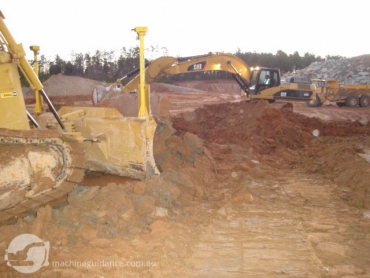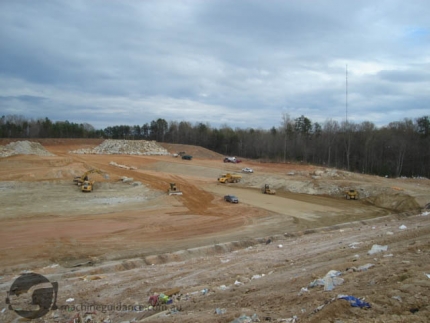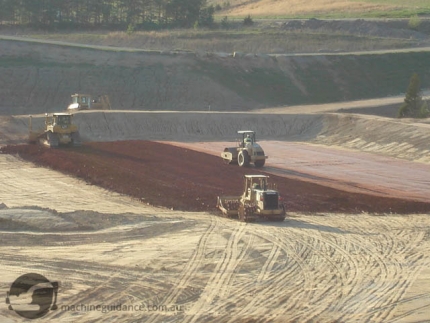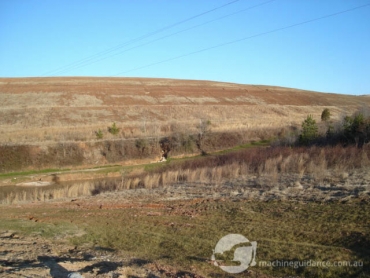Contractor Masters the Complexities of Building Landfill Cells
This article demonstrates how utilising machine control technology helped Sargent Corporation overcome some significant engineering challenges and shave 80 working days off their new landfill site project timeline.
Published: February 2013
Author: Jeff Winke

Text 1
Sargent Corporation understands landfills and the complexities of building them.
Based in Stillwater, Maine, the mid-sized construction contractor serves the mid-Atlantic market, working anywhere from North Carolina to Pennsylvania, Maryland, Delaware and Virginia. Constructing new landfill sites or adding cells to existing ones is a company specialty. And using construction technology to ensure productivity and best results has become Sargent Corporation's hallmark.
"We've been using Trimble systems since 2000," states Jeff Marsh, project superintendent with Sargent Corporation. "We're currently building two landfill cells at the Gaston County Landfill, just north and west of Charlotte, where excellent weather and the Trimble software used to create a digital plan, for data prep, and the GPS machine control helped us trim about 80 working days off our production schedule."
The $1.5 million project is for constructing two adjoining cells, Cell 1C and 2A, on the existing landfill. Sargent is the general contractor on the eight-acre, rectangle-shaped expansion of the municipal solid waste landfill.
"When we arrived at the site, we were fortunate to have the County's survey control monuments established, so within two hours my foreman and I had completed our calibration for our base station," Marsh said. "We mounted our GPS base station unit near our office trailer and we were ready to go."
Sargent used a 36-metric ton excavator to carve out the cell's footprints. There was about 39,000 cubic yards of excavation and 11,000 cubic yards of backfill to fill in the natural depressions. Typically, the excavated material is set aside to be used for covering the daily layer of waste placed in the landfill cell.
"We provided the 2D site plan we received from the County's engineer to Bruce Flora with Flora Surveying and Datapro, Gloucester, Virginia, who created the 3D model we used with our Trimble SPS 851 rover and the dual-mast GPS Trimble GCS900 Grade Control System running on our dozer," states Marsh. "We established a strong working relationship with the Gaston County engineer, so when we encountered some discrepancies with the original design we were able to work it out within a couple of hours and charge forward with no hold up in production. That was huge."
Marsh points out that traditionally if the County engineer would have needed to stop production to redesign and re-issue the site plan that it would have delayed production anywhere from a couple of days to a week or more.
The 3D GPS-based machine control system on the dozer helped Sargent establish the base sub-grade on the two cells and in constructing the two-feet of clay liner which was placed in six-inch lifts.
Even before the base grade elevation was placed, Sargent had to excavate down at least more than a couple feet to make sure rocks or rock outcroppings were removed so they wouldn't migrate up and penetrate the clay liner.

Image 1 LHS

Image 2 RHS

Text 2
"We imported the 19,000 square yards of clay and wanted to make sure we didn't overrun the amounts we used," Marsh says. "Here's where the machine control technology becomes invaluable. The State requires a minimum of two feet, so anything over comes out of our pocket. The regulators shoot the subgrade and then shoot the two-feet of clay to document that we've met the requirement."
The machine control system put design surfaces, grades and alignments inside the cab to accurately position the dozer blade in real time.
After the clay liner, a 60-millimeter-thick High Density Polyethylene (HDPE) sheet is laid from 500-foot rolls before a protective cover-material surface is placed. The 18-inch layer of caliche collection stone is the last layer before the garbage bags of pizza crusts, coffee grounds, meat wrappers, and other household waste begin filling up the cells.
Reflecting on the project, Marsh states that the owner, Gaston County, was very impressed with the quality of the work and how quickly it was completed. "We had approximately 180 days to complete this engineered project and we were finished in 100 days. This helped the County considerably since they could apply for state certification to use the cells sooner than anticipated."

3
So, what were the biggest challenges of this project? Marsh explains:
"Our first challenge was completing the rock excavation and the subgrade simultaneously. We had to wait for our blasting contractor to drill and set off the charges. We had to complete one block at a time - checkerboard style - until shazam, it all comes together. It was a bit of controlled chaos, but the machine guidance technology helped us maintain control.
"The second challenge was placing the lifts of clay. The material required a lot of conditioning to get the proper moisture and meet the compaction curve. The more moisture you have in that material, the harder it is to compact. It's kind of like a tightrope walk.
"The Trimble Grade Control System helped immensely. Imagine without it having to grade eight acres and laying six inches down on it, putting stakes in the ground to show that six-inch layer, and then to show where the next six-inch layer is, and keep building up like that. Where the machine control technology helped is that we didn't have to waste time setting stakes. We could grade exactly a six-inch layer at a time."
With the completion of the two new cells at the Gaston County Landfill, Marsh can look back: "My 12-worker crew and I can be proud of our work here. We saved the County time and money, and made money for our company. It doesn't get any better than to take a final review walk with the landfill manager and have him say, 'We'd be happy to have you back working on this site any day of the week!'"

End Credit
Jeff Winke is a business and construction writer based in Milwaukee, Wis. He can be reached through www.jeffwinke.com.

Return to Articles


